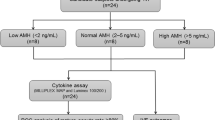Abstract
Background
It has become increasingly clear that the follicular microenvironment of the maturing human oocyte is a determining factor for the implantation potential of an embryo deriving from that oocyte. Indeed the quality and maturity of an oocyte are influenced by the level of intrafollicular oxygen content which, in turn, is proportional to the degree of follicular vascularity. The aim of the study was to establish whether there is a relationship between follicular fluid VEGF concentrations, perifollicular vascularity and reproductive outcome in normal responders under the age of 35 undergoing IVF.
Materials and methods
Sixty-one consecutive patients, all at their first IVF cycle, were included in the study. All patients had primary infertility due to male factor or tubal factor. At oocyte retrieval, the perifollicular vascularity of two follicles per ovary was estimated qualitatively through power Doppler blood flow, for a total of two hundred forty-four follicles. The follicular fluid from the identified follicles was centrifuged and stored until VEGF assay. The maturity and fertilization rate of the corresponding oocytes as well as embryo quality and pregnancy rate were recorded.
Results
In our study, we found VEGF levels to be significantly correlated with grade of perifollicular vascularity. Oocytes obtained from follicles with the higher grade of vascularization also showed a higher rate of fertilization, embryos, a better quality and higher pregnancy rates were obtained in women with highly vascularized follicles. Perifollicular blood flow doppler indices seem to predict oocyte viability and quality. Moreover, VEGF may play a potential role in the development of the perifollicular capillary network.
Discussion
The ability of a given follicle to express VEGF and develop an adequate vascular network may be inter-related in patients under the age of 35. An adequate blood supply may be fundamental important in the regulation of intrafollicular oxygen levels and the determination of oocyte quality.

Similar content being viewed by others
References
Van Blerkom J, Antczak M, Schrader R. The developmental potential of the human oocyte is related to the dissolved oxygen content of follicular fluid: association with vascular endothelial growth factor levels and perifollicular blood flow characteristics. Hum Reprod. 1997;12:1047–55.
Van Blerkom J. The influence of intrinsic and extrinsic factors on the developmental potential of chromosomal normality of the human oocyte. J Soc Gyn Invest. 1996;3:3–11.
Kamat BR, Brown LF, Manseau EJ, Senger DR, Dvorak HF. Expression of vascular permeability factor/vascular endothelial growth factor by human granulosa and theca lutein cells. Role in corpus luteum development. Am J Pathol. 1995;146:157–65.
Lam PM, Haines C. Vascular endothelial growth factor plays more than an angiogenic role in the female reproductive system. Fertil Steril. 2005;84:1775–8.
Gordon JD, Mesiano S, Zaloudek CJ, Jaffe RB. Vascular endothelial growth factor localization in human ovary and fallopian tubes: possible role in reproductive function and ovarian cyst formation. J Clin Endocrinol Metab. 1996;81:353–9.
Moncayo HE, Penz-Koza A, Marth C, Gastl G, Herold M, Moncayo R. Vascular endothelial growth factor serum and in the follicular fluid of patients undergoing hormonal stimulation for in-vitro fertilization. Hum Reprod. 1998;13:3310–4.
Mattioli M, Barboni B, Turriani M, Galeati G, Zannoni A, Castellani G, Berardinelli P, Scapolo PA. Follicle activation involves vascular endothelial growth factor production and increased blood vessel extension. Biol Reprod. 2001;65:1014–9.
Reynolds LP, Grazul-Bilska AT, Redmer DA. Angiogenesis in the female reproductive organs: pathological implications. Int J Exp Pathol. 2002;83:151–63.
Artini PG, Monti M, Matteucci C, Valentino V, Cristello F, Genazzani AR. Vascular endothelial growth factor and basic fibroblast growth factor in polycystic ovary syndrome during controlled ovarian hyperstimulation. Gynecol Endocrinol. 2006;22:465–70.
Friedman CI, Danforth DR, Herbosa-Encarnacion C, Arbogast L, Alak BM, Seifer DB. Follicular fluid vascular endothelial growth factor concentrations are elevated in women of advanced reproductive age undergoing ovulation induction. Fertil Steril. 1997;68(4):607–12. Oct.
Veeck LL. The morphological estimation of mature oocytes and their preparation for insemination. In: Jones HW Jr, Jones GS, Hodgen GD, Rosenwaks Z, editors. In vitro fertilization-Norfolk. Baltimore: Williams and Wilkins; 1986.
Chui DKC, Phugh ND, Walzer SM, Gregory L, Shaw R. Follicular vascularity-the predictive value of transvaginal power Doppler ultrasonography in an in-vitro fertilization programme: a preliminary study. Hum Reprod. 1997;12:191–6.
Gaulden ME. Maternal age effect: the enigma of Down syndrome and other trisomic conditions. Mutat Res. 1992;296:69–88.
Bhal PS, Pugh ND, Chui DK, Gregory L, Walzer SM, Shaw RW. The use of transvaginal power Doppler ultrasonography to evaluate the relationship between perifollicular vascularity and outcome in in-vitro fertilization treatment cycles. Hum Reprod. 1999;14:939–45.
Coticchio G, Sereni E, Serrao L, Mazzone S, Iadarola I, Borini A. What criteria for the definition of oocyte qualità? Ann NY Acad Sci. 2004;1034:132–44.
Van Blerkom J, Davis PW, Lee J. ATP content of human oocytes and developmental potential and outcome after in-vitro fertilization and embryo transfer. Hum Reprod. 1995;10:415–24.
Gosden RG. Oogenesis as a foundation for embryogenesis. Mol Cell Endocrinol. 2002;186:149–53.
Author information
Authors and Affiliations
Corresponding author
Rights and permissions
About this article
Cite this article
Monteleone, P., Giovanni Artini, P., Simi, G. et al. Follicular fluid VEGF levels directly correlate with perifollicular blood flow in normoresponder patients undergoing IVF. J Assist Reprod Genet 25, 183–186 (2008). https://doi.org/10.1007/s10815-008-9218-1
Received:
Accepted:
Published:
Issue Date:
DOI: https://doi.org/10.1007/s10815-008-9218-1




